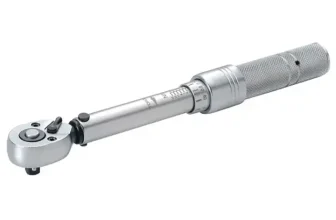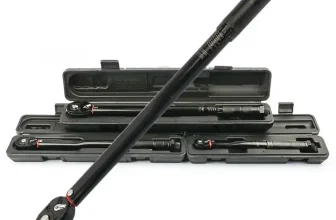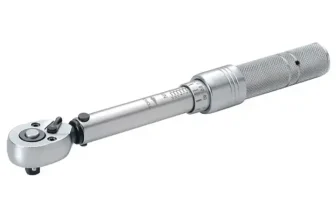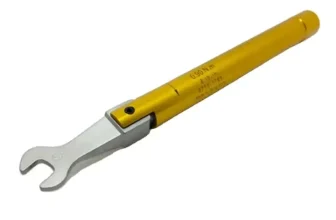The torque wrench dates back to the late 19th Century, although the accurate history remains blurred due to lack of documentation. The need for quality-controlled joint tightening was reflected in the early inventors’ motivations for creating this tool.
Considered the father of the torque wrench, Conrad Bahr introduced the first patented version of this tool in 1918 while working at the New York City Water Department. Bahr’s design was based on the notion that a tightened bolt would eventually ‘click’ when the appropriate torque was reached. This invention assisted in preventing over-tightening and under-tightening of bolts, significantly reducing the frequency of pipe leaks.
In the years that followed, the torque wrench has been continuously improved to adhere to industry needs. For instance, the split beam torque wrench was developed in the 1940s. The development of this style of wrench allowed for greater precision, ease of adjustment, and durability.
Today, torque wrenches are an essential tool in a multitude of professions, including automotive repair, aviation, and construction. They serve as a testimony to the importance of precision and control in fields that demand exactness. With advancements in technology, we are now seeing digital and electronic torque wrenches that provide incredible accuracy. However, the core function and concept remain the same, a testament to Conrad Bahr’s groundbreaking invention over a century ago.
Importance of Torque Wrenches in Various Industries
Torque wrenches are pivotal tools in a multitude of industries. Their primary function is to apply a specific torque to a fastener such as a nut or bolt, ensuring proper tightness without causing damage through excessive pressure. This is critical because incorrect tightness could lead to mechanical failures or reduce the lifespan of the equipment.
The automotive industry extensively uses torque wrenches during the assembly and maintenance of vehicles. Correctly torqued bolts in a car’s engine or wheel hub can mean the difference between safe travels and mechanical disasters.
In the aerospace industry, precision is paramount. Torque wrenches play a crucial role in ensuring the integrity of various components, as even a small miscalculation can lead to catastrophic results in such high-stakes environments. The same applies to the construction industry where structurally sound buildings rely on appropriately torqued fixtures.
Oil and gas operations also employ torque wrenches to prevent leakages in pipe connections, which could prove environmentally and economically costly. Similarly, in electronics manufacturing, torque wrenches are integral for precisely assembling delicate components.
Thus, across various sectors, the application of torque wrenches offers precision, reliability, and safety whilst saving valuable time and resources.
Understanding Breakaway Torque
Definition of Breakaway Torque
Breakaway torque is a mechanical term that refers to the amount of torque necessary to begin the rotation of a static, or stationary, object. In terms of practical applications, it is the force required to “break away” fasteners or screws from a stationary or tightened position.
When you fasten something, such as a nut on a bolt, there comes a point where the nut will no longer turn without applying more force. It has now reached static or breakaway torque. This torque is significantly higher than the force needed to continue to the rotation once it has begun, which is known as running torque.
This concept is crucial in scenarios where components are bolted together. Knowing the breakaway torque ensures these components are tightened accurately and sufficiently, ensuring the stability and reliability of the structure or system in which they are utilized.
Significance of Breakaway Torque in Bolt Tightening
Breakaway torque, also known as static or loosening torque, plays a significant role in bolt tightening applications. Essentially, it serves as the amount of torque needed to overcome the initial resistance to rotation in a fastener, like a bolt. This resistance occurs due to factors such as friction or corrosion and results in an initial “breakaway” or peak torque which is typically higher than the following “running torque”.
The main significance of breakaway torque in bolt tightening lies in its use for quality control purposes. By measuring and monitoring the breakaway torque, operators can ensure that bolts are tightened consistently and safely to their intended specifications. This is especially crucial in industries where accurate bolt tightening is critical for assembly integrity and safety, such as automotive, aeronautical, and construction industries.
The breakaway torque also provides valuable data about the condition of the bolts and the materials they are fastened to. For instance, a higher than usual breakaway torque might indicate increased friction due to corrosion or damage. Identifying these discrepancies early can help prevent equipment malfunction or potential failure.
Therefore, understanding the breakaway torque holds paramount importance in securing the correct assembly and long-standing performance of components, preventing potential premature failures that might bring about costly repairs and downtime in industrial settings.
Introduction to Breakaway Torque Wrench
Basic Definition and Function
A breakaway torque wrench is an essential tool designed to measure and apply the right amount of torque or rotational force needed for a nut or bolt to “break away” from a static position. This breaking away refers to overcoming static or standby friction allowing the bolt or nut to rotate. The primary function of this specialized torque wrench is to ensure accurate torque delivery preventing overtightening or under tightening, which can either weaken the material due to unnecessary stress or lead to loose connections. Appropriate torque application, ensured by a breakaway torque wrench, helps in maintaining the integrity and prolonging the life of the fasteners, thus ensuring the safety and effectiveness of the overall equipment or system.
How a Breakaway Torque Wrench Works
The breakaway torque wrench works in a unique way to effectively control and measure torque, an essential aspect of fastening operations. It is designed to apply a specific torque to a fastener such as a nut or bolt. This ensures the fastener is neither too loose (risking falling out) nor too tight (which could damage the materials being fastened). The functioning of a breakaway torque wrench primarily revolves around its mechanism which indicates or ‘breaks’ when the desired torque has been reached.
Imagine turning a large key to unlock a well-secured door, then feeling the key suddenly give way the moment the door unlocks. That sensation of the key – or, in this case, wrench – suddenly ‘breaking away’ is how this tool got its name.
When pressure is applied to the wrench to tighten a fastener, the wrench’s spring-loaded mechanism remains stiff and resistant, giving the user a firm feeling. As the desired torque is reached, the mechanism subtly gives way or ‘breaks away.’ This change in resistance indicates to the user that the required torque has been applied. This precision makes the breakaway torque wrench an invaluable tool in many industries where maintaining correct torque is essential for safety, production quality, and effectiveness.
Features of a Breakaway Torque Wrench
Design and Mechanical Structure
The design and mechanical build of a Breakaway Torque Wrench sets it apart from other kinds of torque wrenches available in the market. Breakaway torque wrenches are built with specific functionalities and components that make them ideal for measuring breakaway torque.
At first glance, a breakaway torque wrench may look like a typical socket wrench, however, its internal mechanism is where the magic happens. The core component is a calibrated spring that’s linked to the wrench handle. As pressure is applied to the handle and it starts to twist, the spring also deforms accordingly. This is essentially the principle of how torque is measured – the relative deformation of this spring.
Most breakaway torque wrenches have a rachet mechanism which allows the tightening and loosening of bolts without the need to remove the wrench head. When a preset torque level is reached, the breakaway torque wrench provides a discernible mechanical action, such as a “break away” or “slip” function, wherein the grip of the wrench on the fastener is temporarily broken, giving the user an unmistakable signal that the desired torque has been achieved.
The design of the breakaway torque wrench also caters to accuracy. The different parts of the wrench work together to reduce any kind of reaction force that could otherwise affect the accuracy of the reading. As such, this specialized torque wrench is capable of delivering precise and verifiable torque to various types of fasteners.
While the specific design can vary from one manufacturer or model to another, what’s common is the principle of function and the goal of enabling accurate measurement of breakaway torque, supporting a wide range of industrial tasks that demand precision and reliability.
Accuracy and Precision
A standout feature of a breakaway torque wrench is its exceptional accuracy and precision. When it comes to fastening bolts, particularly in critical applications, the tool’s torque control plays a pivotal role. To ensure secure and proper assembly, every fastener must achieve a specific torque value, which makes accuracy an indispensable feature for torque wrenches.
Most breakaway torque wrenches are manufactured to a standard that ensures they offer an accuracy of +/- 3 to 4 percent. This level of accuracy enforces the consistency of bolt tightness across an entire project, diminishing the risk of equipment failure, improper balance, or structural instabilities due to inconsistent fastening.
Real precision in a breakaway torque wrench also lies in its repeatability – the ability to consistently achieve the same torque level multiple times, preserving the integrity of the project. Through their calibrated mechanics, breakaway torque wrenches ensure high repeatable torque accuracy, making them a reliable tool for precision-dependent industries such as automotive, aerospace, and construction. This high degree of accuracy and precision aims to prevent over-torquing or under-torquing, potentially saving significant time, money, and effort on reworks and repairs.
The importance of accuracy and precision for a breakaway torque wrench, therefore, cannot be overstated. It allows professionals to confidently and securely fasten each component to its exact specification, ensuring the utmost efficiency, safety, and durability of the final product.
Adjustability and Flexibility
The adjustability and flexibility factors of breakaway torque wrenches are often appreciated by many professionals who need to use such tools. The ability to fine-tune the torque applied by the wrench, based on the needs of the specific task at hand, is extremely beneficial. This adaptability is usually accomplished through a dial or knob on the wrench itself that allows the mechanic or operative to select the appropriate torque level.
Adjustable torque wrenches often have a torque range usually indicated on the wrench, and once a desired torque is reached, there is a “break away” or slip motion which prevents further tightening.
Flexibility is another advantageous feature found in breakaway torque wrenches. They are often designed to accommodate different sized sockets so that it can be used on a wide range of fasteners. Its reversible ratchet head drives in both directions and measures torque in the clockwise direction.
Being able to adjust the torque level and having a flexible tool that can be used with a myriad of fasteners, not only simplifies the task but also increases work efficiency and ensures accurate results consistently. The advantage of such customizable features comes into full play in situations when there are specific torque requirements as over-tightening or under-tightening can lead to failures, damages or safety concerns.
Using a Breakaway Torque Wrench
How to Use a Breakaway Torque Wrench
Operating a breakaway torque wrench involves a few simple steps. First, you select the correct size socket for the fastener you’re tightening. Attach the socket to the wrench and then adjust the torque setting on the wrench to the desired level. Most breakaway torque wrenches have a scale on the handle that allows you to specify the torque level.
Once you’ve set the torque level, place the socket onto the fastener. Hold the handle and apply slow and steady pressure in the direction you’re tightening. It’s crucial to avoid sudden or jerky movements, which can lead to inaccurate torque application. As the fastener nears the specified torque level, the breakaway mechanism in the wrench will trigger, causing the wrench handle to move freely and thus indicating that you’ve reached the desired torque. This breakaway action prevents over-tightening and potential damage to the fastener or the surrounding material.
It’s important to reset the torque setting on the wrench to the lowest level after every use. This ensures the internal spring does not remain tightened, which could affect the accuracy of future measurements. Proper usage of a breakaway torque wrench can enable precise and efficient fastening, vital for mechanical reliability and safety in various applications.
Safety Tips When Using Breakaway Torque Wrench
Using a breakaway torque wrench may look simple, but like any mechanical tool, it can pose safety risks if not handled properly. Here are some crucial safety tips to keep in mind:
-
Keep your work area clean: Always keep your workspace well-lit and free of any potential hazards. A cluttered or dark work area can cause accidents.
-
Inspect before use: Before using the wrench, ensure that it’s in good condition. Check for any signs of damage such as cracks, corrosion, or wear. Do not use a damaged or malfunctioning wrench as it can lead to accidents.
-
Wear protective gear: Always wear appropriate safety equipment, including gloves, safety glasses, and closed-toe shoes, to protect yourself from flying debris or accidental slips.
-
Use correct posture: Apply force smoothly and evenly, and avoid overreaching or awkward postures which can lead to muscle strain or tool slippage.
-
Do not exceed the recommended torque: Always check manufacturer’s specifications for the recommended maximum torque. Over-tightening beyond the recommended limit may damage the tool or the fastening components.
-
Regular calibration: Improper calibration can impact tool performance and result in safety hazards. Make sure your wrench is correctly calibrated before use.
-
Store safely: After use, clean the wrench and store it in a dry, clean place to prevent any damage or misuse.
-
Use the right tool for the right job: Never use a torque wrench as a hammer or a pry bar. It’s designed for a specific purpose of measuring and applying torque and using it for other tasks can easily damage it.
Remember, safety should always come first when using any type of mechanical tool. By following these guidelines, you can ensure that you’re making the most out of your breakaway torque wrench while keeping yourself and those around you safe.
Selection and Maintenance of Breakaway Torque Wrench
How to Choose the Right Breakaway Torque Wrench
Choosing the right breakaway torque wrench necessitates consideration of several factors. Firstly, assess your specific needs. Consider the type of work you’ll be performing and the level of precision required.
The range of torque that the tool can deliver is a critical factor. Different breakaway torque wrenches have different torque ranges. Pick one that suits the torque specifications of the tasks you’re going to perform. For instance, intricate jobs involving finer screws or bolts will require a lower torque range, while jobs involving larger, heavy-duty bolts will require a higher range.
Next, look at the scale readings on the torque wrench. These readings can be in either metric or standard measurements, depending on the model. Choose a wrench that has clear, easy-to-read measurements, ideally in the form that you’re most familiar with to avoid conversion errors.
Consider the material and construction of the wrench. A tool with robust construction, typically made from strong materials like steel, will be more durable and reliable.
Finally, the grip plays a role in user comfort and efficiency, so choose a breakaway torque wrench that has a comfortable hand grip. This allows for secure handling, reducing the risk of slip-ups or mishaps during work.
Choosing the right breakaway torque wrench ultimately involves knowing your requirements well, doing research on available models, and not compromising on quality for the sake of price. A well-chosen tool should serve you well for many years.
Maintaining and Calibrating a Breakaway Torque Wrench
To ensure the longevity and accuracy of your breakaway torque wrench, regular maintenance and calibration are essential. Maintenance should be simple and largely involves careful handling and storage of the tool. After each use, clean off any dirt or grime that might have accumulated during use, and store it in a dry, room-temperature environment. Avoid overloading or using it for work beyond its capacity, as this will wear out the tool prematurely.
Moreover, calibration is a crucial aspect of maintaining a breakaway torque wrench. This process warrants the tool’s precision over time. Calibration involves setting the tool to exert a known torque and measuring the actual force it exerts. If the actual force doesn’t match the known torque, adjustments need to be made to bring it back into spec.
Manufacturers often provide guidelines on when to calibrate a torque wrench, but a general rule of thumb is to do so after 5,000 to 7,000 cycles or every 12 months, whichever comes first. However, it could be more frequent depending on the intensity of use. For example, professional auto mechanics may need to calibrate their wrenches every few months, while a home mechanic may only need to do so annually.
Companies that specialize in calibration services can perform this task for you or, with the correct tools and knowledge, you can perform the calibration at home. However, please note that improper calibration can significantly affect the wrench’s accuracy, so if uncertain, it’s best to leave this task to the professionals.
In conclusion, careful handling and regular calibration not only keep your breakaway torque wrench working correctly but also extend its lifespan and improve its overall performance.
Applications of Breakaway Torque Wrench
Instances Where Breakaway Torque Wrenches are Key
Breakaway torque wrenches have become a crucial tool in a variety of applications across many industrial environments. These devices especially shine in tasks involving fasteners, where precision and accuracy in the applied torque are paramount.
Automotive or aviation industries frequently employ breakaway torque wrenches during the maintenance and assembly of vehicles. For instance, when technicians are mounting tires or installing engine components, a breakaway torque wrench is an invaluable tool that ensures each bolt is tightened to its correct specification. The incorrect torque can lead not only to loose connections, causing parts to wear out prematurely or fail unexpectedly, but also over-tightening, which can cause equally catastrophic effects.
In the manufacturing sector, these tools play a key role in tightened assemblies that involve critical fasteners, such as in heavy-duty equipment or machinery. These wrenches allow for consistent quality control, ensuring all components are secured adequately.
Construction industries also see a significant use of breakaway torque wrenches. They are used in a variety of tasks from the assembly of steel structures to the installation of HVAC systems. Notably, whenever seismic or structural bolts are used, breakaway torque wrenches ensure that they are tightened correctly to withstand tremendous weights or forces, ensuring the safety and stability of structures.
In the healthcare sector, they are used for delicate, high-precision tasks like in surgical equipment assembly, where the secure and robust fastening of parts can directly impact the success of surgical procedures.
Finally, in DIY applications or home repairs, breakaway torque wrenches are preferred for their precise control, particularly in jobs like bicycle assembly or flat-pack furniture assembly.
In summary, breakaway torque wrenches are employed in a vast array of operations, ranging from complex industrial tasks to simple home DIY jobs, where the precise application of torque is needed to ensure safety, reliability, and performance.
Impact of Breakaway Torque Wrenches in Industries
Breakaway torque wrenches have led to significant advancements and enhancements in numerous industries. In the automotive industry, they are crucial in ensuring that bolts on parts such as wheels, head gaskets, and suspension components are tightened to the manufacturer’s exact specifications. This level of precision not only increases the longevity of these parts but also ensures a high level of safety for drivers and passengers alike.
Similarly, in the aerospace industry, breakaway torque wrenches are fundamental to the assembly of complex machinery and systems. Given that any minor inconsistency can lead to catastrophic outcomes, the precise torque control of these tools ensures the seamless functioning of aircraft and space vehicles.
In the manufacturing sector, the use of these wrenches contributes to the efficiency and effectiveness of assembly lines. By providing the technician with accurate tightening and loosening control, they minimize the risk of part failure or damage, thus reducing downtime and associated costs.
Likewise, the construction and engineering sectors benefit significantly from breakaway torque wrenches. From erecting large structures to fine-tuning delicate installations, the ability to apply the precise amount of torque to fasteners is indispensable.
Moreover, industries that require regular maintenance of equipment utilize breakaway torque wrenches to ensure fasteners are initially tightened and subsequently loosened in a controlled, safe manner. This promotes the longevity and reliability of the equipment, lowering maintenance frequency.
Overall, breakaway torque wrenches have introduced a level of precision and quality control in various industries that was previously unattainable, bringing about notable improvements in safety, efficiency, and effectiveness.
Conclusion
The Breakaway Torque Wrench’s significance cannot be overstated. These tools deliver precise and accurate measurements, ensuring the correct amount of force is applied to a nut or bolt. They’re indispensable in industries such as automotive, aircraft, and manufacturing, because they assure the integrity and safety of various assemblies and installations. The control provided by this tool over the applied torque minimizes the risk of damage due to over-tightening or under-tightening, fostering efficient operations and contributing to the longevity of the equipment. In essence, the Breakaway Torque Wrench is a cornerstone in precision-critical applications, setting a foundation for quality and safety.







